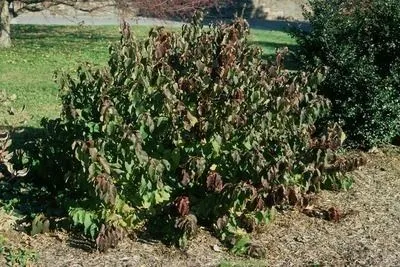
Author: Mill.
Bibliography: Gard. Dict. ed. 8: n.º 5 (1768)
Year: 1768
Status: accepted
Rank: species
Genus: Cornus
Vegetable: False
Observations: EC. & E. U.S.A.
Silky cornel, botanically known as Cornus amomum, is a native species belonging to the Cornaceae family. This deciduous shrub is found primarily in the eastern and central regions of the United States, thriving in moist environments such as wetlands, riverbanks, and along the edges of forests.
First described by Mill. in 1768 in the Gardener’s Dictionary, Cornus amomum has since captivated botanists and horticulturists alike with its distinctive characteristics. The plant typically features smooth, grayish bark and opposite leaves, which contribute to its elegant appearance. The leaves are elliptic to ovate, with a silky texture on the underside—hence the common name “silky cornel.”
In the spring and early summer months, the silky cornel produces clusters of small, white to cream-colored flowers. These blooms are not only attractive but also essential for pollinators, providing a valuable nectar source for bees and butterflies. By late summer to early fall, the flowers give way to vibrant blue drupes that are favored by various bird species. This fruiting period makes the silky cornel an integral part of the local ecosystem, supporting wildlife and contributing to biodiversity.
An adaptable and hardy plant, the silky cornel is well-suited to a range of soil types, provided they are consistently moist. Its tolerance to different environmental conditions makes it an excellent choice for natural landscaping and restoration projects aimed at enhancing wetland areas and stabilizing soil with its robust root system.
Overall, Cornus amomum is not only a plant of ecological importance but also a visually appealing addition to gardens and natural landscapes. Its year-round interest, from its fragrant flowers to striking fall foliage and winter berries, ensures that it remains a valued species among plant enthusiasts and environmentalists.
Eng: kinnikinnik, red-willow, silky cornel, silky dogwood
Deu: seidenhaariger hartriegel
Swe: sidenkornell
En: Silky cornel, Silky dogwood, Red-willow, Kinnikinnik
Be: Свідзіна Амома
De: Seidenhaariger Hartriegel
Sv: Sidenkornell
Taken May 14, 2022 by stephanie mesnage (cc-by-sa)
Taken Dec 16, 2021 by Patrick FOURNIER (cc-by-sa)
Taken Jun 7, 2020 by Ben Epperson (cc-by-sa)
Taken Jun 21, 2020 by Brenda Talaber (cc-by-sa)
Taken Jun 13, 2021 by Ingrid lindemann (cc-by-sa)
Taken Sep 12, 2021 by haven chady (cc-by-sa)
Taken May 17, 2019 by jim rentch (cc-by-sa)
Taken Sep 1, 2022 by J. McConnell (cc-by-sa)
Taken Jun 28, 2022 by jean-pierre Vandenbussche (cc-by-sa)
Taken Sep 14, 2020 by Aurelie Garcia (cc-by-sa)
Taken Sep 10, 2021 by Kathryn Langlois (cc-by-sa)
Taken Aug 25, 2022 by Shoshonah MacKay (cc-by-sa)
Taken Aug 14, 2021 by C Gooch (cc-by-sa)
Taken Aug 9, 2021 by sam schieren (cc-by-sa)
Taken Aug 23, 2022 by Jul31 (cc-by-sa)
Taken Jul 2, 2010 by EOL − Chicago Botanic Garden 2010 (cc-by-nc-sa)
Taken Aug 25, 2015 by EOL − Alison (cc-by-nc)
Taken Sep 13, 2015 by EOL − Fluff Berger (cc-by-sa)
Taken Sep 13, 2015 by EOL − Fluff Berger (cc-by-sa)
Taken Oct 17, 2015 by EOL − partridge (cc-by-nc)
Taken Aug 12, 2020 by syryll ofiana (cc-by-sa)
Taken Nov 23, 2020 by Morgan Morgan (cc-by-sa)
Taken Jun 8, 2021 by Leigha Beliveau (cc-by-sa)
Taken Sep 3, 2021 by marissa fontaine (cc-by-sa)
Taken May 31, 2020 by Lily Jones (cc-by-sa)
Taken Nov 10, 2022 by Passiflore09 (cc-by-sa)
Taken Aug 19, 2022 by Tony F (cc-by-sa)
Taken Sep 12, 2021 by haven chady (cc-by-sa)
Growth form>: Stoloniferous
Growth habit>: Shrub
Growth rate>: Moderate
Ph maximum: 7.0
Ph minimum: 5.0
Family: Myrtaceae Author: (F.Muell.) K.D.Hill & L.A.S.Johnson Bibliography: Telopea 6: 402 (1995) Year: 1995 Status:…
Family: Rubiaceae Author: Pierre ex A.Froehner Bibliography: Notizbl. Bot. Gart. Berlin-Dahlem 1: 237 (1897) Year:…
Family: Sapindaceae Author: Koidz. Bibliography: J. Coll. Sci. Imp. Univ. Tokyo 32(1): 38 (1911) Year:…
Family: Asteraceae Author: A.Gray Bibliography: Pacif. Railr. Rep.: 107 (1857) Year: 1857 Status: accepted Rank:…
Family: Fabaceae Author: Medik. Bibliography: Vorles. Churpfälz. Phys.-Ökon. Ges. 2: 398 (1787) Year: 1787 Status:…
Family: Aspleniaceae Author: (Cav.) Alston Bibliography: Bull. Misc. Inform. Kew 1932: 309 (1932) Year: 1932…